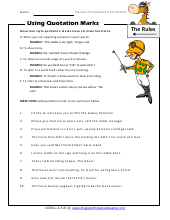Punctuation Worksheets
A great tip to follow when learning new forms of punctuation is to always read sentences aloud, if you are not sure how it should be punctuated.
Punctuation marks are put in place in writing to demonstrate to the reader how a passage was constructed and how it should be read. A comma tells us to take a slight pause. The exclamation mark tells us that the writer had strong feelings coming off a sentence. The period tells us that a thought has ended. A question mark, well, tells us we are looking for a response. When we want to connect two sentences or thoughts, we use a semi-colon. Students have a great deal of difficulty with that symbol's usage. These worksheets will help students master the proper punctuation of various sentences.
Colons - These symbols are used to add a layer of separation between two independent clauses. In most cases the second clause provides an explanation for the first.
Comma Use Within Sentences - When used in this fashion the comma helps the reader gauge what in the sentence is the most important.
Commas in the Beginning and Ends of Letters - We show students how they can be used to start and end a body of work.
Commas and Coordinating Adjectives - This can help a sentence roll off the tongue better.
Commas and Quotation Marks in Dialogue - Understanding placement in dialogue is often a difficult task for most young writers.
Ellipsis Omission - These symbols help writers save space in their work and help point out important things.
End Punctuation - Students will learn what should be placed at the end of a sentence and why.
End Punctuation of Sentences - These are slightly more advanced use of symbols with a purpose.
Exclamation Marks - When you what to express a heightened level of excitement, these are your go to.
Hyphens and Dashes - One puts words together the others pulls them away.
Italics and Underlining - We use this type of formatting to make our words or phrases stick out. We show you how to proper use them.
Periods - We show you how to properly use this symbol to end off complete thoughts.
Punctuation Errors - We work mostly on sentence mechanics and grammar in this section.
Punctuation Pauses and Breaks - When used effectively these symbols can be used to increase the comprehension of your readers.
Question Marks - When you are looking for answers, this is your go to symbol of choice.
Quotation Marks - When you want to compile that exact words that someone has vocalized and written.
The Rules - These worksheets focus on the general rules that govern the use of these marks and symbols.
Semicolons - We use these to join to clauses or parts of a sentence when they are given equal emphasis.
Using Apostrophes - They have many different uses including displaying possession and plurals.
Use Commas in Addresses - This helps you separate the name of a city and a state.
Using Commas in Dates and Single Words - They help use communicate our messages much better.
Using Commas and Quotation Marks - We look at two of the most fundamental grammatical tools in our toolbox.
Using Commas to Separate the Introductions - When we are looking to make a purposeful pause or breather for effect.
Using Commas with Coordinating Conjunctions - When we are linking ideas or concepts.
Using Punctuation for Effect - It is funny how some simple symbols can make your written words more impactful.
Using Punctuation To Separate Items - A super simple way to state a disconnect between items or objects.
Using Punctuation To Set Off Elements - We look at all the different ways in which these unique characters can be used to improve our ability to communicate.
Get FREE English Worksheets In Your Email
